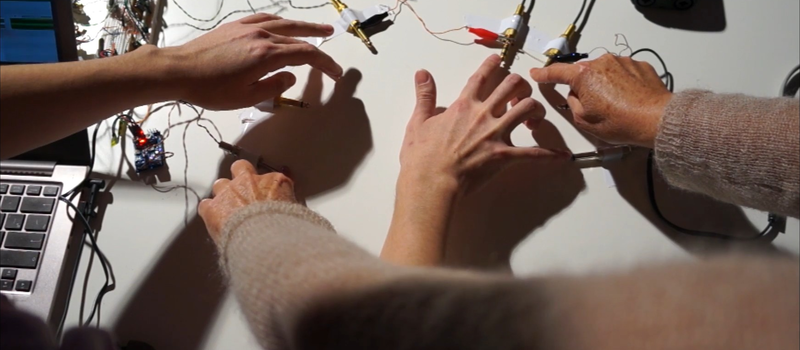It’s hard to make an audio mixer with any less technology than FingerRing (YouTube video, embedded below). We’re pretty sure that [Sergey Kasich] isn’t going to get a patent on this one. But what he does get is our admiration for pushing a simple idea far enough that it’s obviously useful.
The basic idea is transmitting signals using the human body as a conductor. What [Sergey] does is lay out multiple sound sources and sinks on the table, and then play them like a mixer made musical instrument. Pressing harder reduces the resistance, and makes the sound louder. Connecting to two sources mixes them (in you). Watch the video — he gets a lot of mileage out of this one trick.
We can think of a number of improvements to this system. A bunch of nails in a board acting as the contact points would be a lot easier to play than 1/4″ cables taped down to a desk. You could make it a permanent instrument. If you were designing the system from scratch, you’d want high-input-impedance amplifiers on the receiving end. Add a notch filter to kill the mains hum, or an instrumentation amp and another electrode on your ankle. Pretty soon, you’re an EKG and a mixing desk.
The biggest limitation he has is that the body is just one big conductor. Can anyone think of how to get multiple channels through flesh and bone without making the whole setup over-complicated? Now excuse us as we tape instrument cables all over our desk. We’re inspired.
















What can make a great party even better? Fingerring.
Enough to be famous on Hackaday. To really have it take off, nudity, piercings and maple syrup should be added for the ultimate performance art installation.
Used to do this with my tongue when I was a kid.
I read Scramouche’s comment and then yours, I nearly shat myself!
Apparently he likes to Get Down.
This should go over great seeing as how a large number of Netizens are already completely at home with the technique of Fingerring themselves.
Ooops. I think I left out a comma.
At least it wasn’t a period.
Something like this in this would probaly be perfect for the main output.
http://www.stressnomore.co.uk/media/catalog/product/cache/4/image/650x/9ce4d81fc553554f1b698a09f92b64d6/9/2/92243_1.jpg
My wife loves music and electronic instruments. I bet it won’t be long before her fingerring is keeping me up all night.
I remember Fingerring as a child so long ago. The good ole days before my sight left me. Who would have ever thought i’d go blind?
Sweet!
I won’t shill for a particular company, but there are also “hum eliminators” aka “ground lifters” that would help with mains hum.
yeees, I remember when we used to get high and mess with gear. Controlled acoustic feedback and a tennis ball bouncing off a wall as stimulus… good times.
Still, it’s always interesting to think laterally, to try anything, and to let your imagination lead you further. The video delved into some options – like using the signal to control something else. Another possibility is using the ‘body’ path as a secondary controller – converting the signal level and or frequency into another control parameter (eg 0 to 5 v dc to control synthesizers). Resistive paths could be used as real faders or mix busses. Examples are carbon paper… even thick pencil lines on paper.
In my prime experimental days, one great toy was the PAiA Gnome – a micro-synth that could be hacked to bits. For today’s sonic pioneers, there’s a new level of hackability and experimentation with devices like the PatchBlock.
Noodle on…
Boost the voltage to increase SNR? IIRC, it can be up to 30V RMS or 50V peak and still be considered safe to touch, maybe even higher if measures are taken to limit the current.
I’d never tried this before – nice technique to join the grounds. Definitely got mileage in it for installation/instrument design
example of custom interface for FrR & live performance:
https://www.youtube.com/watch?v=DkVVPIgjr-c
also all the info about the technique in one place: http://soundartist.ru/sa-projects/fingerring/